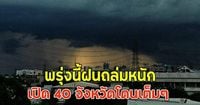On May 2, 2025, Thailand is bracing for a bout of severe weather, as the Meteorological Department has issued warnings about summer storms accompanied by thunderstorms, gusty winds, and the possibility of hail in various regions. The forecast indicates that upper Thailand will experience significant weather changes, prompting officials to alert residents to take precautions against potential dangers.
The weather forecast for the next 24 hours predicts thunderstorms across upper Thailand, particularly affecting the northern, northeastern, and central regions. This includes areas like Chiang Mai, Phitsanulok, and Sukhothai, where thunderstorms are expected to bring heavy rainfall and strong winds. The public is advised to remain cautious of lightning strikes and flash floods that could arise from the heavy downpours.
In Bangkok, the temperatures are anticipated to range from 25 to 27 degrees Celsius at their lowest, peaking at 33 to 37 degrees Celsius during the day. Wind speeds are expected to reach between 10 and 20 km/h. As of 7:00 AM, light to moderate rainfall has already been recorded in various parts of the city, with the highest rainfall measured at the Suan Luang pumping station, which received 32.5 mm of rain. Other significant rainfall records include 29.5 mm in Phasi Charoen and 29.0 mm in Prawet.
The Chao Phraya River's water levels are also under scrutiny, with various stations reporting their levels as of 7:00 AM. Khlong Song (Sai Tai) recorded +1.80 meters above mean sea level, indicating a rise of +0.87 meters. The Saen Saep station in Min Buri reported a steady level of +0.70 meters, while Lad Krabang showed a decrease to -0.26 meters. The river's overall capacity is being monitored closely as the rainfall continues.
As the storms develop, the southern region of Thailand is also expected to face increased rainfall, particularly in provinces such as Nakhon Si Thammarat and Songkhla. Residents in these areas are warned about the risks of flash floods and overflowing waters, especially in low-lying and hilly terrains. The Meteorological Department has highlighted that the southern region may see heavy rain, with thunderstorms affecting approximately 40% of the area.
According to the Meteorological Department, the summer storms are a result of moist winds coming from the east and southeast, which are currently sweeping across the upper parts of Thailand. This weather pattern is expected to persist, with thunderstorms likely to continue until at least May 8, when a more stable weather pattern may begin to emerge.
In addition to the thunderstorms, the forecast suggests that the air quality may be affected by dust and smoke accumulation, particularly in upper Thailand. The air quality in these regions is currently rated as moderate to high due to the ongoing weather changes.
As part of the ongoing preparations, local authorities in Sukhothai Province have already reported damage from the storms that hit the area the previous night, particularly in Amphoe Thung Saliam. Residents in Groups 4 and 10 of Tambon Khao Sri Sombun have been particularly affected, and disaster relief measures are being implemented to assist those in need.
Looking ahead, the Meteorological Department has indicated that Thailand is expected to enter its rainy season around mid-May. This transition is crucial as it will help alleviate the intense summer weather that has been experienced in recent weeks. The public is encouraged to stay informed about weather updates and to prepare appropriately for the upcoming rainy season.
As the weather continues to fluctuate, the Meteorological Department advises everyone to stay vigilant and to heed warnings from local authorities. This includes avoiding outdoor activities during severe weather and ensuring that homes are secured against potential flooding.
Overall, while the summer storms may bring challenges, they also signal the approach of the rainy season, which is vital for replenishing water supplies across the country. Residents are urged to prepare for both the immediate impacts of the storms and the longer-term benefits of the upcoming rains.




